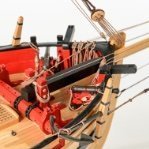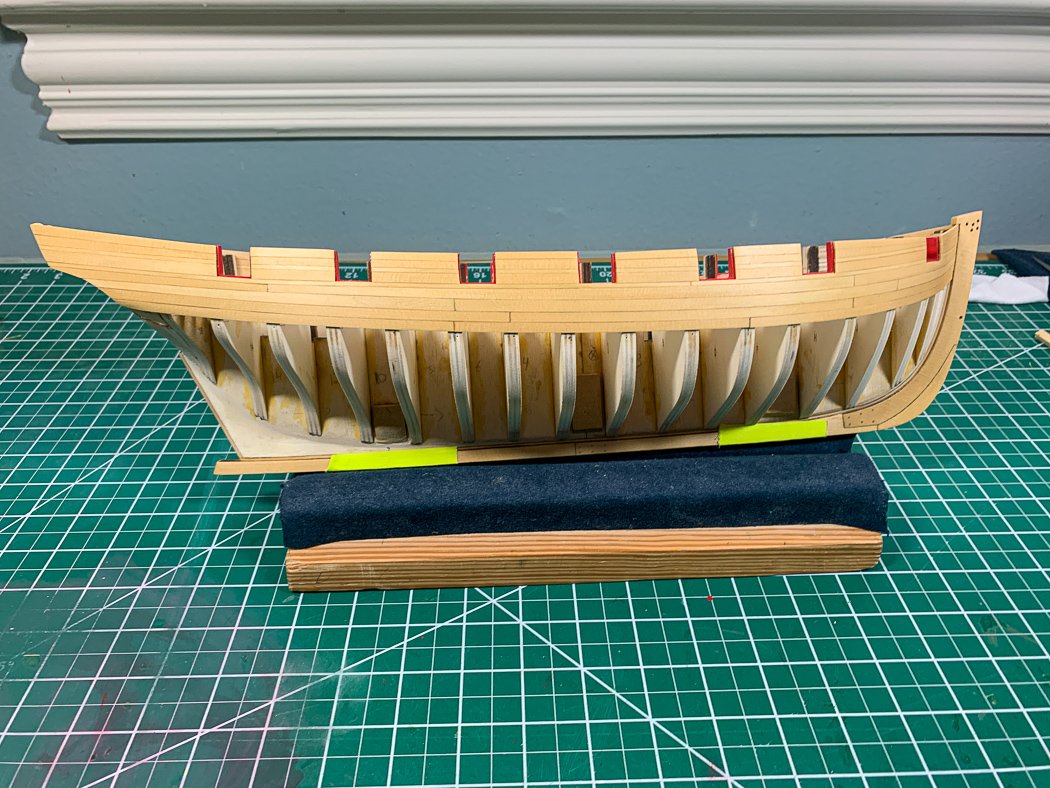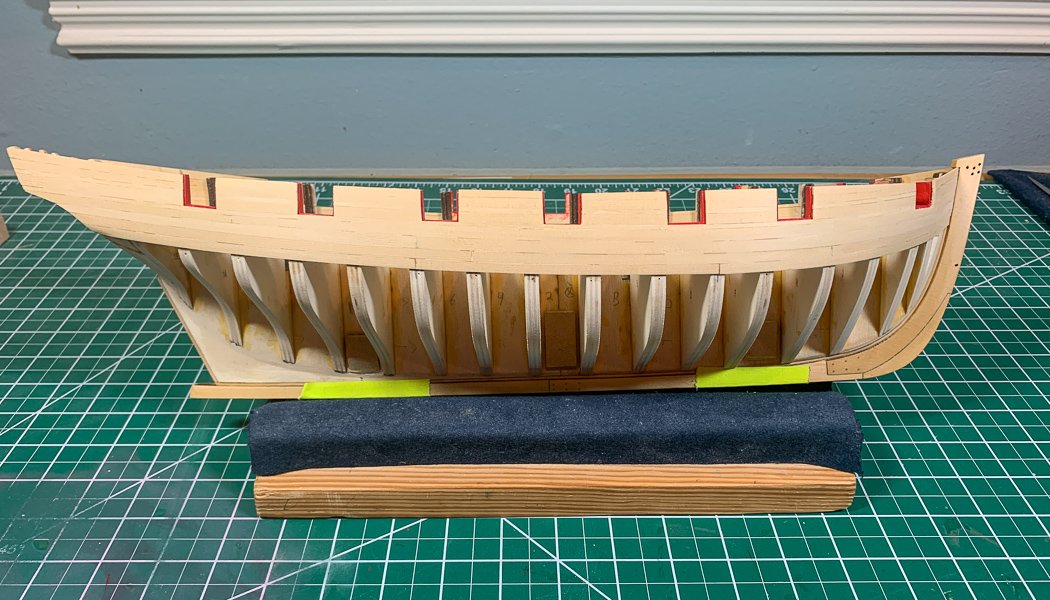-
Posts
4,107 -
Joined
-
Last visited
Content Type
Profiles
Forums
Gallery
Events
Everything posted by glbarlow
-
Well done. I like that the cannon jig has its own stand:-D and thanks for providing a nice reference example for when I get to HM Flirts guns someday. I'm hoping the 1:48 scale of Cheerful will help make it a little easier, maybe just a little.
- 725 replies
-
- vanguard models
- speedy
-
(and 1 more)
Tagged with:
-
The AVS has always been one of my favorite builds. I had a great log here on it, but it along with my Pegasus log went down in flames in the great systems crash. I've backed up every log since, but not those unfortunately. I don't know if I had mentioned here the Bob Hunt Practicum on the AVS, which I believe is still available for sell. As far as you are in your build it would still be helpful for you when it comes time to do the rigging - its here https://www.lauckstreetshipyard.com/ if your interested.
- 108 replies
-
- armed virginia sloop
- model shipways
-
(and 1 more)
Tagged with:
-
Nicely done! That's a bold move having it on a single pedestal, great look.
- 138 replies
-
- glad tidings
- model shipways
-
(and 1 more)
Tagged with:
-
The galleries look really excellent. Great detail and craftsmanship. I would have needed more than one extra.
- 642 replies
-
- winchelsea
- Syren Ship Model Company
-
(and 1 more)
Tagged with:
-
Agree with James, your revised waterline seems more how the boat would float. I often have the same issue thinking the plan water line (of almost every model) is too high. But logically they had to sit pretty low in the water to be under sail.
- 195 replies
-
- lady eleanor
- vanguard models
-
(and 1 more)
Tagged with:
-
BE is right, this works and speeds the process.
- 725 replies
-
- vanguard models
- speedy
-
(and 1 more)
Tagged with:
-
And thank us 3 years from now and think this so much better with them rigged. I do have to acknowledge I never tried it with 4 pounders. That ship needs an armory upgrade. Actually I read the book on Cochran Chris recommended. He tried bigger cannon but it slowed the ship too much. He demonstrated he could carry the entire broadside of cannonballs in his pocket. The net result all these years later, you get to rig tiny cannons.
- 725 replies
-
- vanguard models
- speedy
-
(and 1 more)
Tagged with:
-
Best tool ever, glad you’re liking it too
- 725 replies
-
- vanguard models
- speedy
-
(and 1 more)
Tagged with:
-
I always look at the end of the section I'm working on, if I know what it's supposed to look like when its done its easier following the instructions to get me there. As others noted the first planking serves only as a base for the second. Be comfortable sanding the heck out of it and using wood filler as necessary. The smoother that base becomes the easier and better looking is the the 2nd planking. Think through any tapering you might need to do on the 2nd planking, better yet look at BE's and James builds, they've done one or two so steal, I mean learn whatever you can from their build on the second planking - even if its not in the words you'll see things in the photos. Believe me I'm doing that with my first scratch build in Cheerful - I have 4 particular build logs I look at, only at the post and pages that are at and just after the step I'm on. That's the best thing about this forum, you're not alone. Stealing, I mean adopting the best practices of others is how we all get better. If all else fails leave the area a few up from the keel and below the curve of the side until last. If you have to fill it in, fill it in a place where you can't see it when it's sitting on the shelf. Don't tell anybody I told you that, the perfectionists just fell off their chairs. Me I never make a mistake, that I can't hide. I'm a big fan of @chris watton and Vanguard Models, I'm first in line (at least in my mind) for his shipwright version of HMS Flirt and already have HMS Speedy. I believe you chose wisely, not only because of the superb instructions but because Chris is a world class designer. AND he's on this forum so you can always ask the guy who designed or his ace master builder @James H any question. Here's my modeling maxim: It won't all go perfect, mistakes are a part of the process. The best fun is to Adapt, Improvise, Overcome. Clint Eastwood borrowed that quote from me, no wait - I stole it from him. Have fun, power through any frustrating moments, get to the other side and enjoy your work. That's my whole list of platitudes for the day, I'm all out now.
- 38 replies
-
- vanguard models
- fifie
-
(and 2 more)
Tagged with:
-
I know what you mean, planking below the wales is always an adventure curving both in and down or up depending on how you look at it. As I hope you'll see when I get there Chuck's bending method is even more mind blowing, I'll bend a board upward (in a 2D view) to get it to fit the inward bend of the bow. It doesn't look like it works until you lay the board on and then you go "wow."
- 778 replies
-
- cheerful
- Syren Ship Model Company
-
(and 1 more)
Tagged with:
-
Thanks Chuck, I understand and good point. I haven't touched the sheer yet, I plan to wait until the other side is done so I can even them both up at the same time. I'll run a board along the top with a level to make sure I don't get out of whack on one side. I left the top planks just a tad higher than the bulkhead extensions to make sure I had a little room to work with.
- 778 replies
-
- cheerful
- Syren Ship Model Company
-
(and 1 more)
Tagged with:
-
Interesting question Jim. I don't know a lot about sanding sealer but the big thing about wipe on poly is how it's absorbed into the wood and brings out the color. Again I'm no expert but I think that poly is a form of sealer and putting on actual sealer before would defeat part of the purpose of the poly. Perhaps the sealer, like gesso, is as a first step to painting? It would be interesting to hear from anyone with more experience with sealer, I haven't used it myself.
- 778 replies
-
- cheerful
- Syren Ship Model Company
-
(and 1 more)
Tagged with:
-
Thanks Rusty! The wow factor of a single light coat of wipe on poly (not even dry yet). While it serves to highlight where more sanding is needed (but I knew that) it certainly serves to demonstrate the Alaskan Yellow Cedar is pretty nice stuff.
- 778 replies
-
- cheerful
- Syren Ship Model Company
-
(and 1 more)
Tagged with:
-
I’ve finished Starboard above the wales. It’s very slow going measuring out each of the 4 planks (one just 1/16th, the others 5/32) between the ports to keep the 1/64th rabbet. I've only done preliminary sanding I don't need to go to far on that as yet. I wish I could impart some sage wisdom on cutting these, but its just grinding it out with careful measure and cutting. More finely and carefully than I’ve ever had to do on any kit. I finally determined the best way for me is using my Veritas mini- chisels to cut the planks on carefully measured and marked lines using the sides as the ports to mark the angle from the in-board side. I will have to build up the sill on port 3 by 1/64th. I have a plan, but it will keep until I thin out the bulwarks and before I put in the false deck, so a while from now. I’ve already tried it, it works. Still it’s pretty amazing to me with all that it took with aligning port sills and wales to the frame to get here that I was that close to being right. Once again I attribute it to the design, Chuck's great monograph, and some peaceful patience on my part (something I’m that good at). In case you missed it earlier, the green gaffer tape (a photographers best friend, it leaves no residue and is thicker than blue painters tape) is to protect the keel while the ship is in the Amati keel holder for working angles. Wondering if I should I apply a coat of wipe-on poly to this completed side above the wales, or wait until later. I’ve already lightly sanded parts of the stem and keel and plan to re-apply poly there after I’ve completed the above wales planking and stern before starting on planking below the wales. Any thoughts on the timing of the poly? I will be sanding it more later, just don’t want to over-sand at this point. This single planking stuff can cause some anxiety knowing what I see now is what I’ll always see… Now on to port side…
- 778 replies
-
- cheerful
- Syren Ship Model Company
-
(and 1 more)
Tagged with:
-
Chuck sells a 2.5mm block that will work for cannon rigging
- 725 replies
-
- vanguard models
- speedy
-
(and 1 more)
Tagged with:
-
I did full rigging for Pegasus, Granado, and Pickle. While it is hard and scale is a challenge it is worth it. With as good a job as you’re doing on Speedy I think you’d later regret not doing it. I’m looking forward to it for Cheerful at 1:48.
- 725 replies
-
- vanguard models
- speedy
-
(and 1 more)
Tagged with:
-

Mini Table Saw recommendations
glbarlow replied to captainscott's topic in Modeling tools and Workshop Equipment
But no different than plans, they buy a superb model like Byrnes, then first reverse engineer it, then make it with cheaper parts and without R&D cost. Their primary fighter jet is a knockoff of a Russian one, they know no bounds. -

Mini Table Saw recommendations
glbarlow replied to captainscott's topic in Modeling tools and Workshop Equipment
Let’s not buy these. No different than buying ZHL models, it’s IP theft. Jim Byrnes shouldn’t lose money to Chinese knockoffs -
The failure was with a cheaper version of aliphatic glue, not CA or PVA. I've used the same top brand of CA for my models for years, I've never ever had a failure. Some of my models are 20 years old at this point. I'm very comfortable with CA. I use only CA for planking, no reason or desire to change there. I know there are many that use PVA for hull planking, I'm not one of them. I was thinking about the aliphatic more for the deck and deck furniture since it dries clear and doesn't seem to stain. There is a difference between white PVA and Tite Bond, and even Tite Bond has three different formulas one of which I think is phatic I believe. I'm looking for those that experience with AliPhatic and its best use (if there is one)
-
I've read a number of builders, particularly our English friends, using Aliphatic Glue. I thought I'd give it a try and just received some from my favorite English Model Shop, Cornwall Model Boats. Any experience or observations on using Aliphatic glue vs. CA and Tite Bond beyond the obvious point about set up times? I've always and will continue to use CA for planking, I'm comfortable with that just as I use Tite Bond for gluing bulkheads and frames. I'm wondering where, or if, Aliphatic Rapid Glue can improve my modeling perhaps for deck furniture or even deck planking? Does it hold up, is there some subtle advantage to it vs. others? I tried another cheaper version of this type of glue for cleats on bulwarks only to find it didn't hold up to the tension of a rigging line. Just looking for thoughts, observations, and experience of my fellow MSWers...
-
Now use the airbrush to paint your mill and the mill to carve your initials in the airbrush 🤣😂
- 725 replies
-
- vanguard models
- speedy
-
(and 1 more)
Tagged with:
About us
Modelshipworld - Advancing Ship Modeling through Research
SSL Secured
Your security is important for us so this Website is SSL-Secured
NRG Mailing Address
Nautical Research Guild
237 South Lincoln Street
Westmont IL, 60559-1917
Model Ship World ® and the MSW logo are Registered Trademarks, and belong to the Nautical Research Guild (United States Patent and Trademark Office: No. 6,929,264 & No. 6,929,274, registered Dec. 20, 2022)
Helpful Links
About the NRG
If you enjoy building ship models that are historically accurate as well as beautiful, then The Nautical Research Guild (NRG) is just right for you.
The Guild is a non-profit educational organization whose mission is to “Advance Ship Modeling Through Research”. We provide support to our members in their efforts to raise the quality of their model ships.
The Nautical Research Guild has published our world-renowned quarterly magazine, The Nautical Research Journal, since 1955. The pages of the Journal are full of articles by accomplished ship modelers who show you how they create those exquisite details on their models, and by maritime historians who show you the correct details to build. The Journal is available in both print and digital editions. Go to the NRG web site (www.thenrg.org) to download a complimentary digital copy of the Journal. The NRG also publishes plan sets, books and compilations of back issues of the Journal and the former Ships in Scale and Model Ship Builder magazines.




